
Antennas
 |
Amateur Radio Station N4EKV
Antennas |
|
Home |
Op |
QTH |
Rig |
Keys |
Ant |
QSL |
/QRP |
/P |
/M |
/K |
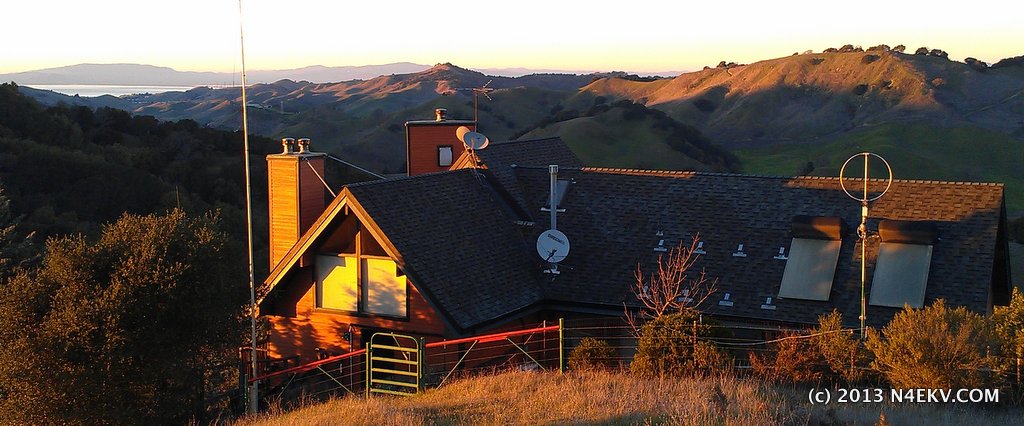
|
The 50ft Zero Five guyless vertical has weathered several winter storm seasons without breaking a sweat. It's a noisy receive antenna, however, which is why I just purchased a receive-only antenna (more info below). |
|
|
|
|
|
|
|
|
|
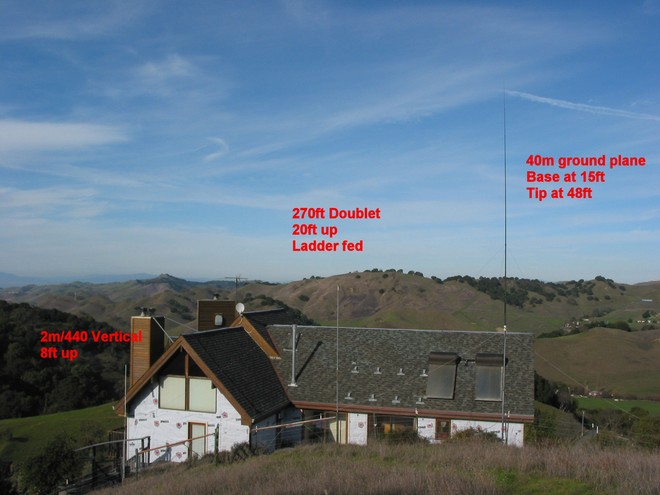
|
Past antennas, from right to left: The 40m ground plane uses a DK9SQ 33ft telescoping fiberglass pole sitting atop a 10ft piece of 1-1/2" PVC conduit which in turn is supported by a 2" steel fence post sunk in cement. Guys at the 15ft (GP's base) and 25 ft (top of 3rd DK9SQ section) levels keep it aloft! Four down-sloping 33ft radials make the SWR <1.5:1 across the entire 40m and 15m bands. This is an excellent DX antenna, pulling in distant sigs that my 160m doublet couldn't even detect. EZNEC says it has a take-off angle of just 22-degrees. 660K image of the guying system and hub here. The white piece is a 1-1/2" PVC repair junction that mates the 10ft PVC support mast with the base of the DK9SQ (requires filing the raised ridge from the bottom of the DK9SQ.. a 5-min task). A flange mount SO-239 acts as the hub for the antenna and a simple U-bolt holds the feedline's PL-259 connector to the repair junction as well as anchoring the first tier of 3/32" Dacron guy lines. A 2.5mH RF choke wrapped in coax seal shorts the radiator to the coax shield to drain static build up (important!)
The house was undergoing a re-siding project when the above photo was taken which necessitated the removal of my rotary EDZ (seen below) from the chimney. |
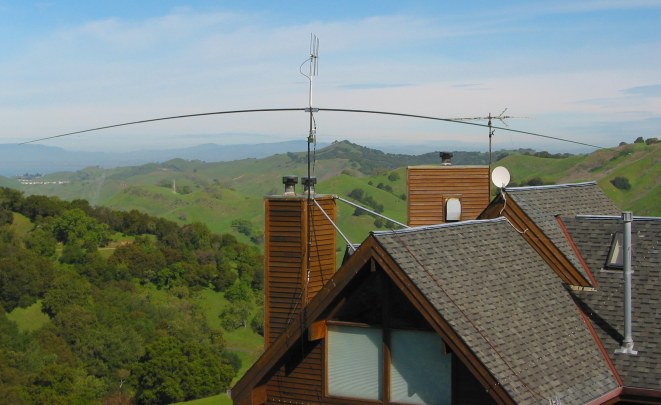
|
Rotary extended double zepp (EDZ) for 10-40 meters. Homebrew contruction, 44ft tip to tip. Fed by 450-ohm ladder line and balanced L antenna tuner. This design by L.B. Cebik provides nice bidirectional gain with low take-off angles. It performs exceptionally well on 20m!
Update: With L.B. Cebik's blessing I extended the 44ft antenna to 50ft by using 1/8" solid rods extending from the 22ft fiberglass poles' tips which I soldered to the wire elements and secured just beyond the poles' tips with copper split bolt connectors. This simplified tuning on 40m at the expense of a more lobed radiation pattern on 10 and 12 meters.
Elk Antennas 2m/440 5-element log periodic beam seen above the EDZ. WARNING to those whose antenna tuners don't provide a DC ground to both ladder line leads: Perhaps due to the fiberglass poles, this antenna collects large amounts of static electricity which gets carried down the ladder line to my shack. RF chokes to ground on each side of the ladder line drain the static. Update: This antenna was installed in March 2003 and hasn't endured as well as I had hoped. The fibreglass poles are sagging noticably and one of the joints slipped causing the stinger to slip out of the tip and sag down. The fiberglass is fading pretty badly from the sun. The short mast I used on top of the rotor eventaully slipped in the rotor clamp and is now pretty much freewheeling making the antenna useless. It's a 3-man job to get it down from its guyed 21ft 2" water pipe so it remains un-fixed and unused until I devise a one-man raise/lower support for my "tower". |
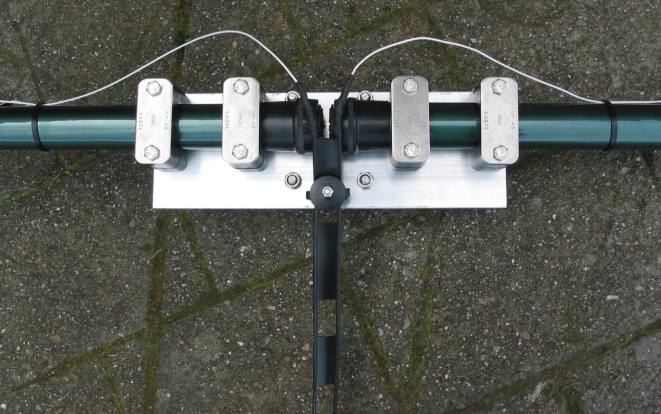
|
Detail of the EDZ hub assembly. 4x12x3/8 inch 6061 aluminum stock from Metal Supermarkets. 22ft telescopic fiberglass poles from The Mast Company. Radio Support Blocks from DX Engineering. The 22ft wire elements were quickly relocated to run inside the poles when the wires started slapping in the wind during ground-level testing. Elastic shock cords tied to the ends of the wires and extending through the pole tip fittings keep the wires fully extended and rattle-free. Electric fence insulator acts as strain relief for dangling ladder line. |
|
Elk Antennas 2m/440 log periodic beam, now removed and used (occasionally) to work the ham satellites. Mounted on 1" PVC mast to avoid interaction with elements. Coax is deliberately routed in a perpendicular path from the element plane per manufacturer's recommendation. Update: This $39 TV rotator did not have nearly enough capacity for this antenna! Not only couldn't it turn the antenna into any wind above 20mph, but the unit completely failed after only three months in service. I've procured a rebuilt CDE CD-44 rotator that will be replacing it.
| |
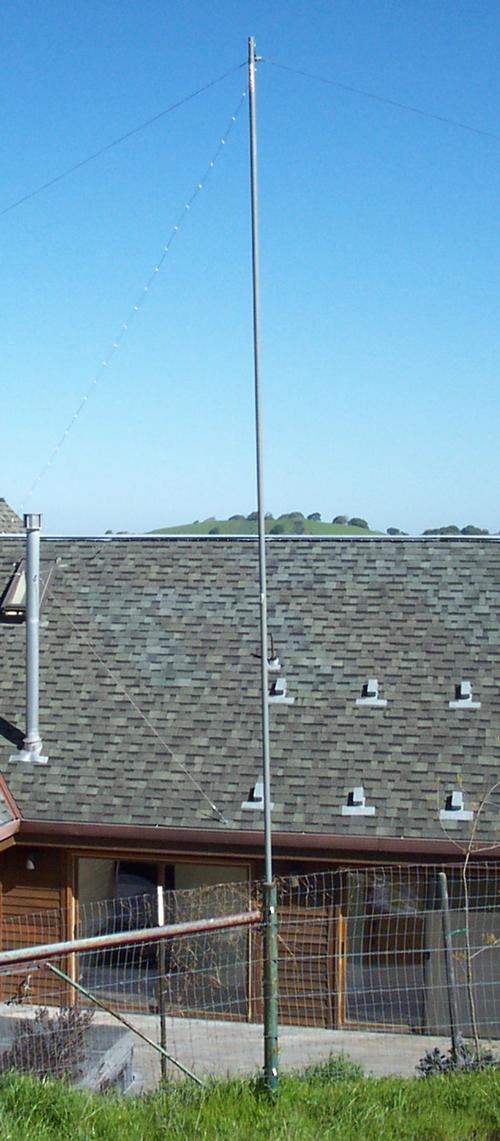 |
160m ladder-fed doublet. Two 10ft Radio Shack TV masts clamped to a handy fence post support the center of the doublet. The legs are 135ft each and they slope downwards to similar supports at the end points. Due to the curvature of the hill, the wire is only 6-7ft from the ground at some points, despite heavy weights stretching it via pulleys from the ends. Old fashioned ladder line feeds the antenna. |
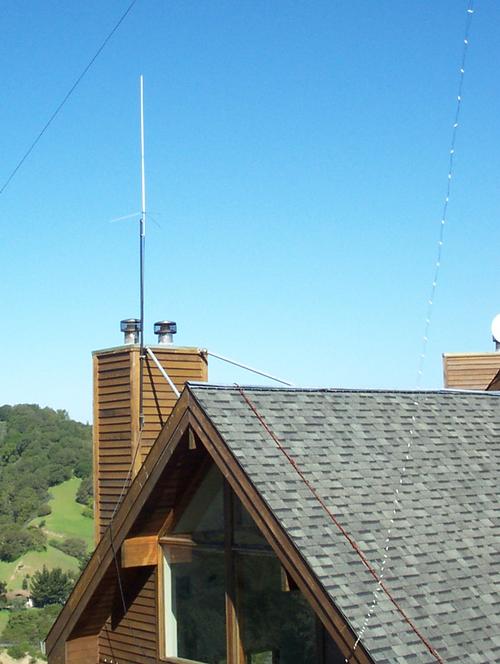 |
This is a high-gain 2m/440 vertical. it delivers 6db gain on 2m and 8.2db on 440. Fed by RG-9913, the ground plane is close to the 1000ft elevation mark. Ladder line leading to the doublet is visible in the foreground. OOS March 2003 to install EDZ and 2m/440 beam. That's one steep roof for climbing! Note the red and black rope I have in place to make the job safer. Still, it's like repelling on my way down! |
|
How to keep the feed line tidy? Electric fence insulators! The XYL still hates it..
|
|
Home |
Op |
QTH |
Rig |
Keys |
Ant |
QSL |
/QRP |
/P |
/M |
/K |
|
Copyright © 2002-2025 N4EKV.COM - All Rights Reserved Site by Norcal Internet LLC |